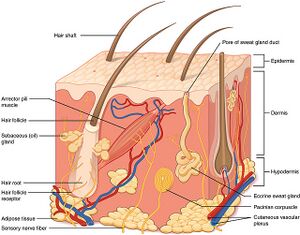Physiology of Sweat
Physiology of sweat[edit | edit source]
Types of Sweat Glands[edit | edit source]
- Eccrine – These are the most distributed throughout the body, and are distributed throughout the entire surface area. They produce the most sweat. There are about 2-4 million glands throughout the body. They are found on both glabrous (palms, soles) and non-glabrous parts of the body. Density of these glands is not uniform throughout the body, as they are the most dense in palms and soles (~250-550 glands/cm2). These are activated by emotional and thermal stimuli. [1]
The density of these glands on non-glabrous skin, like the face, trunk, and limbs, are ~2-5x less than on glabrous skin. These are more variably distributed, and mainly function with temperature regulation. [1]
It is seen that the number of eccrine sweat glands are fixed throughout life, and start developing in infancy. This explains why the density of these glands decrease as a person develops and grows, and their skin expands. This is known to be inversely proportional to body surface area. Therefore children have a greater density of sweat glands than adults, and obese people of any age are seen to have a lower density of eccrine sweat glands. [1]
Despite this, having a greater density of sweat glands does not indicate that the person would sweat more. The differences between sweating rate throughout the body, or different areas of the body, would be due to the sweat secretion rate per gland, compared to the total number of active sweat glands. The contents of eccrine sweat are mainly water and NaCl. It also contains chemicals from interstitial fluid and the eccrine gland. [1]
Eccrine sweat glands can also be thought of as an excretory organ, since they excrete waste products as well. [1]
- Apocrine – These are larger than eccrine glands, and open into hair follicles, instead of being directly on the skin.
Apocrine sweat glands are present in the: axilla, breasts, face, scalp, and perineum.
Similar to the eccrine glands, they are present from birth/childhood, but unlike the eccrine glands they do not start secreting until puberty. Apocrine glands produce viscous, lipid-rich sweat, which consists of proteins, and ammonia. This gland can be known as the scent gland, which is involved in producing pheromones, having an important social and sexual function in humans. [1]
- Apoeccrine – These develop from eccrine sweat glands between the ages of ~8-14 years. They share properties of both eccrine and apocrine glands and are medium in size. These are only found in the axillary region. [1]
They are similar to eccrine glands, as the distal duct connects to and empties sweat onto the surface of the skin, and they produce a large amount of salt water secretions. [1]
Here is a video explaining sweat glands, with some additional information: [2]
Composition of Sweat[edit | edit source]
Although sweat is mainly water and NaCl, there are many other minerals and constituents as a part of its composition. These include: [1]
- ↑ 1.0 1.1 1.2 1.3 1.4 1.5 1.6 1.7 1.8 Baker Lindsay B. Physiology of sweat gland function: The roles of sweating and sweat composition in human health. Temperature. 2019:6(3):211-259.
- ↑ Know The Science. Types of Sweat Glands and their Functions. Available from: https://www.youtube.com/watch?v=Qq46UIGbxxs&ab_channel=KnowTheScience (accessed 24 June 2022).







